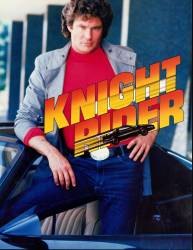Revealing mistake: Across the whole show you see the interior of KITT as being futuristic and curved towards the driver. Also you notice the steering wheel isn't a circular wheel, but a futuristic 'half wheel' with handles. But when you see shoots from a distance you see stunt men driving the car, you can see a normal steering wheel and a normal dash.
Factual error: Realistically, there is no way someone can be thrown straight up from the driver's seat of a Pontiac Trans-Am, even with T-tops. Whoever was being shot straight up would probably break their legs on the crossbar that's adjacent to the windshield.
Continuity mistake: At the beginning of many shows it will show the car's instruments, panning from one to the other. The speedometer will show various speeds in that shot, but a close up of the gauge will then show 55 MPH.
Other mistake: 99% of the shots when Michael presses the 'Turbo Boost' button, it's the same shot repeated over and over.
Revealing mistake: In most episodes you can tell different versions of the car are being driven. In most close up shots, or inside the car, KITT has a distinct black panel on the top part of the windshield and no rear view mirror. In some shots, the black panel has a different shape. But in most wide shots where we see real life driving, there is no black panel at all and sometimes there's a rear view mirror that can be seen. You can also see a normal steering wheel in driving scenes, especially during stunts.
Revealing mistake: The inside shots of Kitt's voice modulator are repeated over and over, with the camera slightly moving sideways, to give the impression of the car running. Problem is, many times the car is at a standstill, so the moving camera shot is inconsistent.






Answer: I would say that unless there's visual evidence it was another K.I.T.T. car, as in you could see the bar scanner or cut steering wheel, people on here would correct the mistake by saying more than one 1982 Pontiac Firebird Trans-Am was sold and there's no reason it's meant to be a random car.
Bishop73